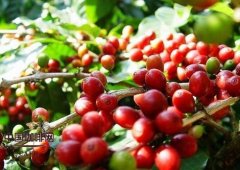Coffee growing area of Galapagos Islands composed of volcanic piles and lava
The annual precipitation along the coast is only 250 mm, and there are tall trees. Island animals strange, especially to giant turtles, lizards known. In 1535, Spanish navigator Thomas de Belangar led a fleet to the islands and landed. In 1832, it was returned to Ecuador. In 1835, British naturalist Darwin visited the islands. The rare fauna on the islands played a great role in demonstrating his theory of biological evolution. More than half of the population lives on San Cristobal Island, where the coastal population engages in fishing and the highland population cultivates maize, sugar cane, coffee, cotton, vegetables, tropical fruits, etc. Sulphur and salt minerals. Baltra has an airport. Tourism is growing. There are Galapagos sea lions, Galapagos turtles, frigate birds, booby birds, marine iguanas, red crabs and other wildlife, Galapagos marine iguanas are good swimmers and can dive to 15 meters, where they can stay for 30 minutes. Male iguanas can reach heights of 1.3m and females 0.6m. 1959 Establishment of the Scientific Research Station for Biological and Natural Environment on San Cristobal Island. Due to its unique ecosystem, UNESCO declared it a "natural wealth of mankind" Colón, Spanish: Galapagos Islands Islas Galápagos is a province of the Republic of Ecuador located on the equator in the eastern Pacific Ocean, 970 km from the coast of Ecuador, between 1°40′ N and 1°25′ S latitudes and 89°14′ W and 92°01′ W latitudes. It has a total land area of 8,010 square kilometers (3,090 square miles) and consists of 7 large islands, 23 small islands and more than 50 rocky reefs. Isabella Island is the largest, with an area of 4,275 square kilometers. Baltra, Santa Maria, Isabella, San Cristobal and Santa Cruz are inhabited islands. Population: 26,640 (2012). The capital is Puerto de Bakriso on San Cristobal Island. The archipelago consists entirely of volcanic mounds and lava, and is rugged, with volcanic cones, crags, and cliffs, the highest peak being Wolf, which rises to 1,707 meters (5,600 feet) above sea level. The climate is affected by the Peruvian cold current, cool and dry, with little precipitation, and the annual average temperature of Puerto Bakriso is 23.8 ° C. There are only small lakes and springs on the island

Important Notice :
前街咖啡 FrontStreet Coffee has moved to new addredd:
FrontStreet Coffee Address: 315,Donghua East Road,GuangZhou
Tel:020 38364473
- Prev

Coffee in Tanzania (Tanzania) Coffee boutique coffee in the Mohi area of Mount Kilimanjaro
Boutique coffee has a strict grading system. Generally, raw beans are preserved in parchment coffee beans in the form of endocarp after processing, and the endocarp is removed before export. Go through a strict grading process to ensure the uniformity of quality. And it is very important to preserve the protection in the process of transportation, such as the control of temperature and humidity, the control of ventilation, avoiding odor adsorption and so on.
- Next

Yemeni coffee bean mocha coffee Yemeni boutique coffee sun treatment yemen
Boutique coffee has a strict grading system. Generally, raw beans are preserved in parchment coffee beans in the form of endocarp after processing, and the endocarp is removed before export. Go through a strict grading process to ensure the uniformity of quality. And it is very important to preserve the protection in the process of transportation, such as the control of temperature and humidity, the control of ventilation, avoiding odor adsorption and so on.
Related
- Does Rose Summer choose Blue, Green or Red? Detailed explanation of Rose Summer Coffee plots and Classification in Panamanian Jade Manor
- What is the difference between the origin, producing area, processing plant, cooperative and manor of coffee beans?
- How fine does the espresso powder fit? how to grind the espresso?
- Sca coffee roasting degree color card coffee roasting degree 8 roasting color values what do you mean?
- The practice of lattes: how to make lattes at home
- Introduction to Indonesian Fine Coffee beans-- Java Coffee producing area of Indonesian Arabica Coffee
- How much will the flavor of light and medium roasted rose summer be expressed? What baking level is rose summer suitable for?
- Introduction to the characteristics of washing, sun-drying or wet-planing coffee commonly used in Mantenin, Indonesia
- Price characteristics of Arabica Coffee Bean Starbucks introduction to Manning Coffee Bean Taste producing area Variety Manor
- What is the authentic Yega flavor? What are the flavor characteristics of the really excellent Yejasuffi coffee beans?

